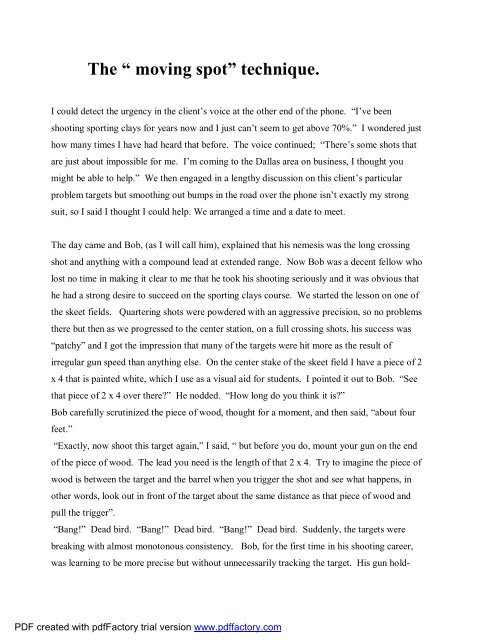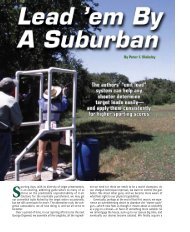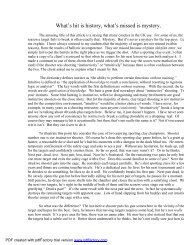The “ moving spot” technique. - Pete Blakeley
The “ moving spot” technique. - Pete Blakeley
The “ moving spot” technique. - Pete Blakeley
- No tags were found...
Create successful ePaper yourself
Turn your PDF publications into a flip-book with our unique Google optimized e-Paper software.
<strong>The</strong> <strong>“</strong> <strong>moving</strong> <strong>spot”</strong> <strong>technique</strong>.I could detect the urgency in the client’s voice at the other end of the phone. <strong>“</strong>I’ve beenshooting sporting clays for years now and I just can’t seem to get above 70%.” I wondered justhow many times I have had heard that before. <strong>The</strong> voice continued; <strong>“</strong><strong>The</strong>re’s some shots thatare just about impossible for me. I’m coming to the Dallas area on business, I thought youmight be able to help.” We then engaged in a lengthy discussion on this client’s particularproblem targets but smoothing out bumps in the road over the phone isn’t exactly my strongsuit, so I said I thought I could help. We arranged a time and a date to meet.<strong>The</strong> day came and Bob, (as I will call him), explained that his nemesis was the long crossingshot and anything with a compound lead at extended range. Now Bob was a decent fellow wholost no time in making it clear to me that he took his shooting seriously and it was obvious thathe had a strong desire to succeed on the sporting clays course. We started the lesson on one ofthe skeet fields. Quartering shots were powdered with an aggressive precision, so no problemsthere but then as we progressed to the center station, on a full crossing shots, his success was<strong>“</strong>patchy” and I got the impression that many of the targets were hit more as the result ofirregular gun speed than anything else. On the center stake of the skeet field I have a piece of 2x 4 that is painted white, which I use as a visual aid for students. I pointed it out to Bob. <strong>“</strong>Seethat piece of 2 x 4 over there?” He nodded. <strong>“</strong>How long do you think it is?”Bob carefully scrutinized the piece of wood, thought for a moment, and then said, <strong>“</strong>about fourfeet.”<strong>“</strong>Exactly, now shoot this target again,” I said, <strong>“</strong> but before you do, mount your gun on the endof the piece of wood. <strong>The</strong> lead you need is the length of that 2 x 4. Try to imagine the piece ofwood is between the target and the barrel when you trigger the shot and see what happens, inother words, look out in front of the target about the same distance as that piece of wood andpull the trigger”.<strong>“</strong>Bang!” Dead bird. <strong>“</strong>Bang!” Dead bird. <strong>“</strong>Bang!” Dead bird. Suddenly, the targets werebreaking with almost monotonous consistency. Bob, for the first time in his shooting career,was learning to be more precise but without unnecessarily tracking the target. His gun hold-PDF created with pdfFactory trial version www.pdffactory.com
gate for access. I pointed it out to Bob.<strong>“</strong>See that gate over there?” Bob nodded. <strong>“</strong>How long do you think it is?” Bob carefullyscrutinized the gate, thought for a moment, and then said, <strong>“</strong>about 10 or 12 feet.”<strong>“</strong>Near enough, now shoot this target again,” I said, <strong>“</strong> but before you do, mount your gun on theright side of the gate. When the target is at the other end, that’s the lead you need. Try toimagine the gate is between the target and the barrel when you trigger the shot and see whathappens, in other words, look out in front of the target about the same distance as the length ofthat gate and pull the trigger. Just lock onto the target, make sure you develop the linecorrectly, then look out ahead to where you think the target will be when the shot charge getsthere and trigger the shot.”Bob couldn’t believe his ears. <strong>“</strong>You mean, I shouldn’t be looking at the target when I triggerthe shot?”<strong>“</strong>Nope, not if you want to hit it,” I said. <strong>“</strong>If you want to hit it, you’ll be looking at the space infront of the target where it’s going to be when your shot arrives. If your gun fits you, it willshoot where you look, right? If you’re looking at the target as you trigger the shot and thetarget’s <strong>moving</strong>, you’re going to hit exactly what you were looking at -- the space where thetarget was when you pulled the trigger. Besides, if it was the right way to do this, the targetwould be breaking, wouldn’t it?” Bob looked puzzled. <strong>“</strong><strong>The</strong>re is a way to shoot targets atextended ranges where you don’t look at the target as you trigger the shot and it works for a lotof shooters,” I continued. <strong>“</strong>Try it and see.”Bob carefully positioned himself for the shot. I bet was more apprehensive than he was, silentlypraying that this time, the target would break.<strong>“</strong>Pull!” <strong>The</strong> target screamed across the tree line and seemed to remain in view forever. Bobsmoothly inserted on the line in front of it, stayed with it for a heartbeat, and, (I was peeringdown the barrel over his shoulder), at exactly the right time in my mind, he fired. <strong>The</strong>re was anoticeable delay between the report of the gun and the shot column reaching the target, but thetarget broke. <strong>The</strong> look on Bob’s face was a picture and he came out with a few choiceadjectives that I had never heard before in Scotland.<strong>“</strong>Were you looking at the target as you pulled the trigger?” I asked Bob.<strong>“</strong>No, I was looking out in front, just like you said I should,” he replied. I explained to him thatwith narrow angles and trap-type targets he could get away with looking at the target as hePDF created with pdfFactory trial version www.pdffactory.com3
triggered the shot. On targets of this sort, minimum angle and a wide shot pattern is usuallyenough to save the day and that is why he had been successful with the quartering targets andsometimes successful on the full crossers at moderate ranges. But with full crossing shots atextended range targets and also in many other situations with complicated, compound leads, hewould need to apply something more specific if he was to improve his 70% average.On certain presentations, I advise many of my clients to initially focus on the leadingedge of the target to define the line, and then look out in front as they trigger the shot to wherethey want their pattern to go. It is called the <strong>“</strong><strong>moving</strong> spot <strong>technique</strong>.” <strong>The</strong> late NashBuckingham first described it many years ago, and many other top shooters use it successfullytoday. <strong>The</strong> most note-worthy of these is none other than Richard Faulds, but many others,including Jon Kruger, also use it successfully. I then went into a lengthy explanation aboutcentral and peripheral vision and how the <strong>“</strong>imaginary <strong>spot”</strong> <strong>technique</strong> of applying lead works.But Bob looked puzzled and shook his head in disbelief, as most of my clients do when I tellthem this.<strong>“</strong>Do you remember what your visual perception of the distance in front of the target was?” Iasked him. Bob nodded. <strong>“</strong>See if you can do it again”. Bob proceeded to do just that, severaltimes. He shot the rest of the course as if he was floating on air but my story does not end there.<strong>The</strong> next week I heard from him again. He excitedly explained that his shooting haddramatically improved but there was another reason for the call.<strong>“</strong>Remember what you said about primary concentration on the target and then looking at aspace in front of the target as you trigger the shot?” he asked. <strong>“</strong>Well, I found an article aboutJon Kruger and guess what? He says the same as you! I’ll fax you a copy.” I thanked Bob andsaid that I would like to read the article.Sure enough, on page 50, in the December 1998 issue of Sporting Clays magazine, there was anexcellent article by Nick Sisley entitled <strong>“</strong>Stellar Star of the Game.” I quote from the article:
ird. This is why lead is essential. Of course, target speed and distance govern how far ahead ofthe target Kruger will be trying to focus.>>.So why does this <strong>technique</strong> work? For some of us, establishing longer leads causes problems,it’s a sort of anxiety separation thing. We feel the need to focus on something solid. We try tofocus on the target and the gun in the same frame but of course we can’t, our eyes don’t worklike that. So, on these extra long crossing shots, as we look so far ahead that the target fadesinto our peripheral vision what do we do? You’ve guessed it, look at the gun. Even a quickglance back at the bead or barrels and the established lead will evaporate, resulting in aninevitable miss behind. And the more lead the targets needs, the more this happens. Learningto apply the <strong>moving</strong> spot <strong>technique</strong> stops this but it doesn’t work everyone. Of course, you stillhave to learn exactly how far in front of the target to look and you still have to have a smoothswing and a gun that fits, but with practice you will learn the required leads. With goodcoaching, you will learn them quickly. So before you dismiss the concept of doing this, onSOME of your targets, why not give it a try? You never know, you may just reap the benefitsand find a few extra targets. And that’s not a bad thing for any of us is it?Since 1998, <strong>Pete</strong> <strong>Blakeley</strong> was the shooting coach at one of the most elaborate and prestigiousgun clubs in the world, the Dallas Gun Club in Lewisville, Texas. Now in 2004 he hosts clinicsat various locations throughout the US. His recently released book <strong>“</strong>Successful Shotgunning”(published by Stackpole Books, September 2003) is considered by many to be the most elaborateand definitive guide to shotgunning ever written. For more information or to schedule a lesson,click on his web. site at www.peteblakeley.com or contact him at 940-321-4997.PDF created with pdfFactory trial version www.pdffactory.com5
PDF created with pdfFactory trial version www.pdffactory.com6





